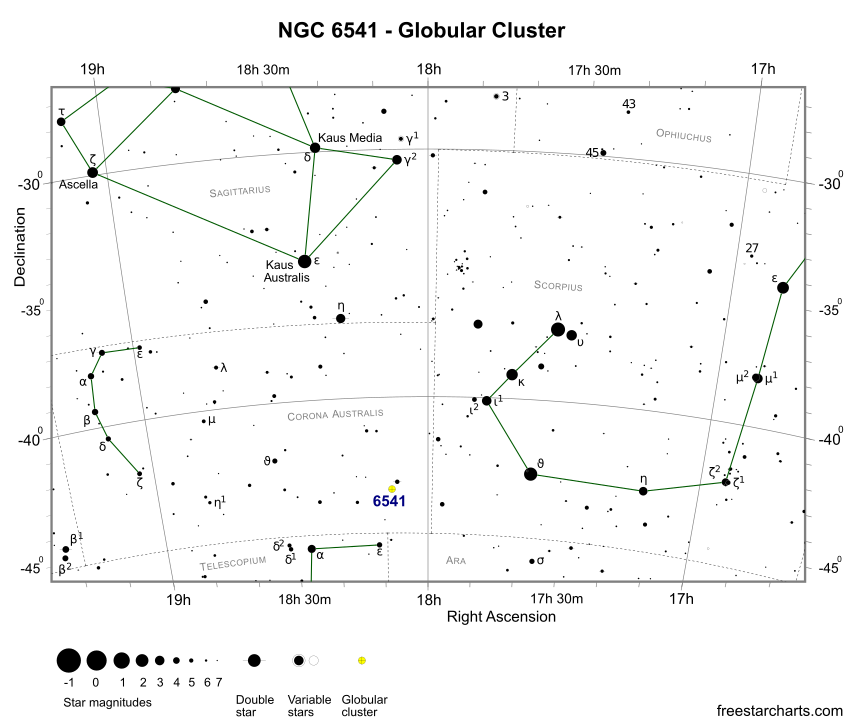NGC 6541, also known as Caldwell 78, is a globular cluster in the southern constellation of Corona Australis. It shines at mag. +6.3 and therefore just beyond naked eye visibility, but easily seen with binoculars and small scopes. Although often overlooked and not as spectacular as the great southern showpiece globulars, it's still a fine object in its own right.
NGC 6541 was discovered by Niccolò Cacciatore at the Palermo Astronomical Observatory, Sicily, on March 19, 1826. James Dunlop independently found it a few months later on July 3, 1826. The cluster is best seen from southern regions during the months of June, July and August. From locations north of latitude 47N, it never rises above the horizon.


Finder Chart for NGC 6541 - pdf format (credit:- freestarcharts)
To find NGC 6541 look towards the southwest corner of Corona Australis. It lies 4 degrees west-northwest of Alpha Telescopii (α Tel - mag. +3.5) with the bright curved tail and sting of Scorpius positioned a few degrees further northwest. Located a third of a degree from NGC 6541 is SAO 228708 (mag. +4.9). This star acts as a good marker, appearing in the same binocular and low power telescope field of view.
In total, NGC 6541 spans 15 arc minutes of apparent sky. Binoculars show a much smaller, hazy glow about 3 arc minutes across that obviously non-stellar. Small scopes do somewhat better. Through an 80mm (3.1-inch) instrument, it appears almost twice the size and hints on resolution.
The brightest member stars at the edges are resolvable at high magnifications through a 200mm (8-inch) telescope. The core remains bright, compact but unresolved. With a 350mm (14-inch) scope or larger, NGC 6541 is a dazzling sight with many stars visible. It becomes gradually denser as you move towards the core, but resolving the core remains challenging.
NGC 6541 is very old at almost 13 billion years. It was once thought to be about 16 or 17 billion years old, which would make it older than the current accepted 13.7 billion year age of the Universe! However, recent cluster age measurements have rectified the issue.
NGC 6541 is 22,800 light-years distant, which corresponds to a spatial diameter of 100 light-years. It contains approx. 150,000 stars.
NGC 6541 Data Table
| NGC | 6541 |
|---|---|
| Caldwell | 78 |
| Object Type | Globular Cluster |
| Constellation | Corona Australis |
| Distance (light-years) | 22,800 |
| Apparent Mag. | +6.3 |
| RA (J2000) | 18h 08m 03s |
| DEC (J2000) | -43d 42m 57s |
| Apparent Size (arc mins) | 15 |
| Radius (light-years) | 50 |
| Age (years) | 12.93 Billion |
| Number of Stars | 150,000 |